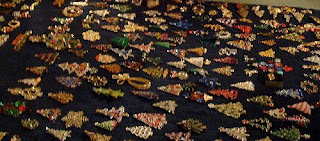
Valentine's day is just around the corner. So now is the time to find that perfect expression of love for the special person in your life.
Jewelry always makes a special gift for a loved one at any time of the year. But Valentine's day lends itself to this expression of love because so many jewelry items can be heart shaped.
Hearts lend themselves particularly well to brooches and pins. Whether it be rhinestones, pearls, or plain metals, a heart brooch makes a perfect "I love you" gift. Some even incorporate additional words on them, such as mother and grandmother.
Heart lockets give your special one a place to put a small picture or lock of hair to remember you by. I've also seen lockets that are shaped like hearts which have small areas inside for solid perfume.
Some designers use figural motifs in their designs. I recently listed a a really cute pin in my

store in the shape of a tic tac toe design, but the Os were small hearts. So cute!
There are charm bracelets with love themed charms, or heart charms, such as this pretty charm bracelet with both pale green and dark green glass heart charms.
But nothing says "I love you" quite the way that this stunning vintage charm bracelet does. It has a hand wired faux pearl strand with a single large heart. The heart is double sided and says I love you in 15 different languages.
I'm not an expert on languages. I know quite a bit of

French, and some Italian and Spanish and I can recognize a few other languages, so I had to go searching.
I googled the spelling of some of the wording on the heart, and came up with this group of countries:
- French
- English
- Greek
- Kurdish
- Portuguese
- Danish
- Nowegian
- Polish
- Italian
- Gaelic
- Chinese
- Hebrew
- Spanish
- plus a few more I can't figure out!
Don't go the flowers and candy route this year. Give the personal gift of a piece of jewelry. This
stunning bracelet is featured in my ebay store Carolina Collections Vintage Jewelry with a price of only $29.99. Say
I love you to the special person in your life, in the language of your choice! The store also has a wide range of all types of
vintage and new heart jewelry for all tastes and budgets.




















 always check out the blogs of note from google to see what the creater of the newest addition like to write about.
always check out the blogs of note from google to see what the creater of the newest addition like to write about.


 At the top of the list is a rhodium plated setting. It was extensively used by the better jewelry designers. Rhodium is a hard metal in the platinum group and it wears extremely well. Two well known designers who used platinum settings often are B. David, and Sarah Coventry. As you can see from the picture to the right, a rhodium setting is smooth and every even. It has a luster to it that normal silvertone settings doesn't have and it doesn't tarnish
At the top of the list is a rhodium plated setting. It was extensively used by the better jewelry designers. Rhodium is a hard metal in the platinum group and it wears extremely well. Two well known designers who used platinum settings often are B. David, and Sarah Coventry. As you can see from the picture to the right, a rhodium setting is smooth and every even. It has a luster to it that normal silvertone settings doesn't have and it doesn't tarnish 





























